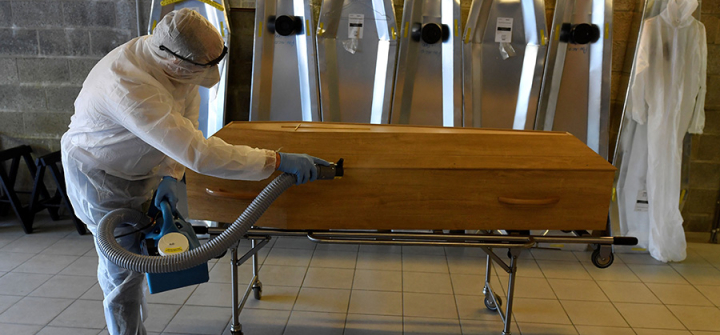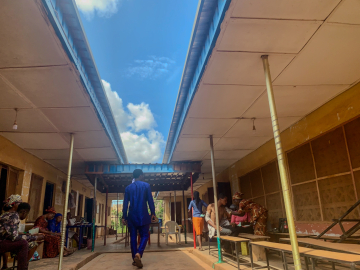Make All COVID-19 Deaths Count
The heaviest-hit city in the heaviest-hit country? My hometown.
Sint-Truiden is a quaint town of just 40,000 people, considered the “Fruit Capital” of Belgium. A small town filled with proud and hard-working locals, known across the country to be ”e ras apoat” (“a special kind” in our local dialect). Little did we know we would become the spotlight of the world.
On April 18, the UK’s Sky News broke the news: We briefly became the epicenter of the COVID-19 pandemic—recording the highest per-capita COVID-19 deaths in the country with the purported highest per-capita COVID-19 deaths in the world.
While the specific reasons why our town “took the lead” have yet to become clear, Belgium was a perfect breeding ground for the spread of COVID-19. The country’s outbreak started from cases returning from skiing trips in Italy. And in February, hundreds of thousands of Belgians come together to mark carnival. On top of that, Belgium has one of the highest population densities among European countries, making it easier to transmit quickly. These factors helped Belgium become reported by some as the world’s deadliest country.
Yet unlike in much of Italy and Spain, Belgium’s health system never faltered and intensive care capacity “barely” reached 70% during the peak in April.
What happened?
Contrary to approaches in many other countries, Belgium made an extraordinary effort to provide accurate mortality data on COVID-19. Its Federal Public Health Service not only counted in-hospital confirmed deaths but also out-of-hospital and COVID-19-suspected deaths. The strategy was vital to enacting rigorous lockdown measures across all sectors between mid-March and mid-May. It helped bring the country back from its peak of 342 reported COVID-19 deaths on April 12 across just 11.5 million people—when mortality was double the expected number of deaths—to near-zero coronavirus deaths just weeks later.
More than half of the recorded COVID-19 deaths in Belgium took place in nursing homes and long-term care facilities, where symptoms were used to estimate COVID-19 deaths for those who weren’t tested. Fewer than 5% of deaths from these facilities were test-confirmed as having been infected; others were merely suspected COVID-19 deaths.
Based on realistic number of COVID-19 deaths, officials in these facilities quickly took steps to prohibit family visits, isolate residents from each other, and maintain stocks of personal protective equipment through both inter-facility sharing and community donations.
While inflating the death count and suffering a catastrophic impact on the country’s reputation seems counterintuitive, this strategy is, in fact, recommended by the WHO and the European CDC.
However, most countries have done the opposite and have underestimated local spread by counting only in-hospital deaths. These numbers often compare poorly with the excess mortality relative to similar periods in previous years. Belgian officials understood that not knowing the true gravity of a situation leads to insufficient measures. (They also pursued the exact opposite course of President Trump’s bizarre, anti-testing strategy: “If we stop testing right now, we'd have very few cases.”)
If Belgium’s experience with the high out-of-hospital mortality can be extrapolated, it may well be that true death tolls in some countries are likely up to twice as high as reported. The excess mortality rate, compared to death rates in the years before, in Belgium is comparable to that of neighboring countries. However, while France followed Belgium’s reporting approach, the Netherlands and others have grossly underestimated their COVID-19 mortality.
Much as the premise that “vulnerable populations would die anyway” is morally wrong, so is the neglect of appropriately addressing the impact of COVID-19 on out-of-hospital populations.
I lost two family members during this pandemic; both were counted as COVID-19 fatalities. Elsewhere, they may not have been. In essence, their deaths would have been swept under the carpet, minimizing the gravity of the outbreak.
A pandemic is not a time for concerns about political reputation or repercussions on tourism; it is a time to make all deaths count and appropriately respond to those numbers.
My family members counted and so should the hundreds of thousands of others around the world who likely have been—and will be—left out.
Dominique Vervoort, MD, is a Belgian doctor and an MPH/MBA student at the Johns Hopkins Bloomberg School of Public Health and the Johns Hopkins Carey Business School. He completed the Paul Farmer Global Surgery Fellowship at Harvard Medical School, focusing on health systems strengthening in low- and middle-income countries.
Ed. Note: For GHN's latest coverage of the coronavirus, visit here. And, please send GHN any questions you'd like to see answered related to the coronavirus outbreak. Just email Dayna (dkerecm1 at jhu.edu).
Join the tens of thousands of subscribers who rely on Global Health NOW summaries and exclusive articles for the latest public health news. Sign up for our free weekday newsletter, and please share the link with friends and colleagues: https://www.globalhealthnow.org/subscribe
A Chaudoir funeral home employee disinfects the coffin of a COVID-19 victim in Namur, Belgium on April 20, 2020. Image: John Thys/AFP via Getty Images




